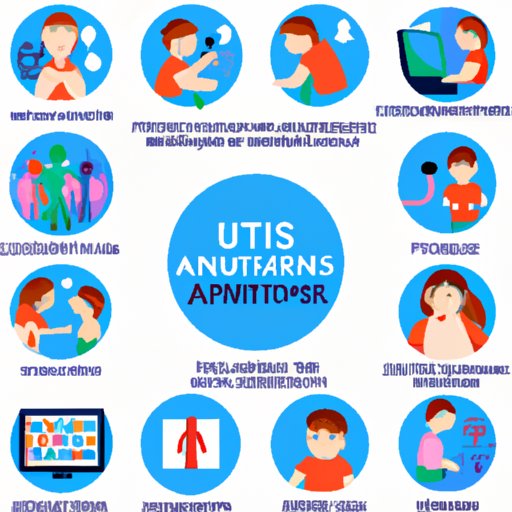
Introduction
Autism spectrum disorder (ASD) is a neurodevelopmental condition that affects social communication, behavior, and sensory processing. According to the Centers for Disease Control and Prevention (CDC), around 1 in 54 children in the United States are identified with ASD. Despite its prevalence, it can be challenging to recognize the symptoms and seek proper diagnosis and support. In this article, we will discuss how to know if you have autism, the process of diagnosis, and the importance of early intervention and support.
Symptoms to Look Out For
Autism is a spectrum disorder which means that individuals with autism experience symptoms to varying degrees. The common symptoms of autism include:
- Difficulty with social interactions
- Repetitive behaviors
- Sensory processing differences
- Speech delays or unusual speech patterns
- Difficulty with change or transitions
Other symptoms that individuals with autism may experience include anxiety, depression, and developmental delays. It’s essential to note that not every person with autism experiences all of these symptoms, and some may have other symptoms that are not listed here. Healthcare professionals use a specific set of criteria to diagnose autism, and it’s important to seek professional help for proper diagnosis and support.
Online Screening
There are online screening tools available to determine if you or a loved one might have autism. While these tools can provide preliminary information, it’s important to note that they are not a substitute for a professional evaluation. Here are some credible online screening tools:
- M-CHAT – Modified Checklist for Autism in Toddlers
- RAADS-R – Ritvo Autism and Asperger Diagnostic Scale-Revised
- AQ-10 – Autism-Spectrum Quotient 10-item scale
Completing these screening tools involves answering a series of questions related to autism symptoms. After completing the questions, the tool will provide a score and recommendations. It’s important to keep in mind that these online screening tools should supplement seeing a professional rather than replacing it. Seeking professional help is necessary for a proper evaluation and diagnosis.
Diagnostic Assessments
The process of diagnosing autism involves seeing a medical health professional or a neuropsychologist who is experienced in diagnosing ASD. The assessment consists of several steps, including:
- A comprehensive medical and developmental history assessment
- Observation of social and communication skills
- Cognitive, language, and behavioral testing
- Interviews with parents or caregivers
The purpose of these steps is to gather information about an individual’s symptoms and experiences. These assessments can help confirm or rule out a diagnosis of autism. Assessment tools that are commonly used by healthcare professionals include the Autism Diagnostic Observation Schedule (ADOS), the Autism Diagnostic Interview-Revised (ADI-R), and the Childhood Autism Rating Scale (CARS).
Personal Stories
Learning about personal experiences of individuals with autism can be illuminating. Many individuals who have received an autism diagnosis have shared their journey to finding out about their condition. It can be a challenging and emotional process as it involves understanding why one’s brain processes information differently than others. However, receiving a diagnosis can also be empowering and can provide a roadmap for finding the right supports and resources.
Individuals on the autism spectrum may experience challenges with social communication, sensory processing, and behavior. These challenges can affect daily activities and social interactions with others. Nonetheless, it’s important to recognize that autism can often provide unique strengths and abilities that others do not possess. For instance, many people with autism are highly adept at pattern-recognition, detailed-oriented observations, and have excellent long-term memories.
Early Intervention
Early intervention is critical for individuals identified with autism. When an individual receives an early diagnosis and intervention, it can have a substantial impact on their cognitive and social abilities. Some early intervention strategies and therapies that can be helpful include behavioral therapy, speech therapy, occupational therapy, and special education services such as individual education plans (IEPs). Early intervention can increase the likelihood of a better outcome and quality of life. Parents and caregivers of children with autism can also benefit from education and training to help support their children’s developmental needs.
Challenges and Support
Individuals on the autism spectrum can face a range of challenges, such as navigating social situations, communication difficulties, and sensory processing differences. It’s important to recognize that every individual with autism has unique needs and strengths. Approaches to support should be personalized and tailored to address each person’s needs. Support for individuals with autism can include therapy, medication if needed, support groups, and assistive technology. Building a supportive network that comprises family members, friends, and healthcare professionals can be valuable in helping individuals with autism navigate life’s challenges.
Resources
There are many organizations and websites that offer information, support, and resources for individuals on the autism spectrum, their families, and educators. Here are some helpful online resources:
- Autism Society
- Autism Speaks
- The National Autism Association
- Autistic Self-Advocacy Network
- The Thinking Person’s Guide to Autism
There are also many relevant books and documentaries that can provide valuable insights and information about autism. These resources can help expand one’s knowledge and understanding about this complex developmental disorder.
Conclusion
We hope that this article has provided some helpful information on how to recognize the symptoms of autism, seek professional help, and find the right support and resources for individuals on the autism spectrum. Early intervention and education can have a substantial impact on an individual’s abilities to navigate social interactions, communicate effectively, and lead fulfilling lives. Education and understanding about autism can help to promote acceptance and inclusivity, leading to positive outcomes for everyone in the community.




